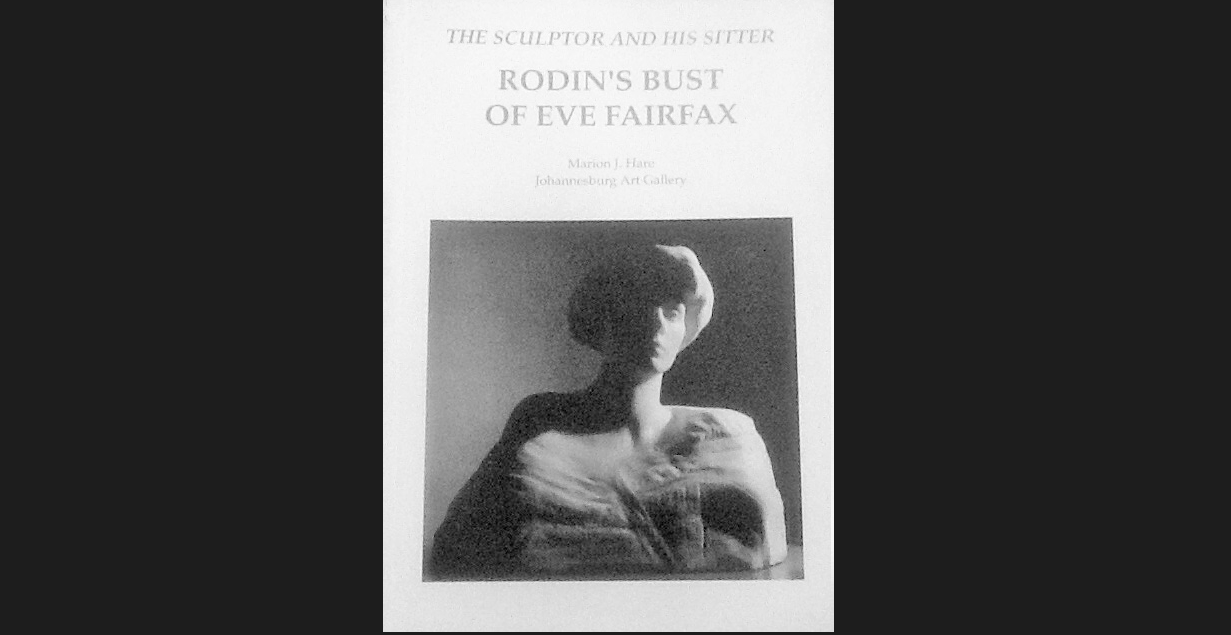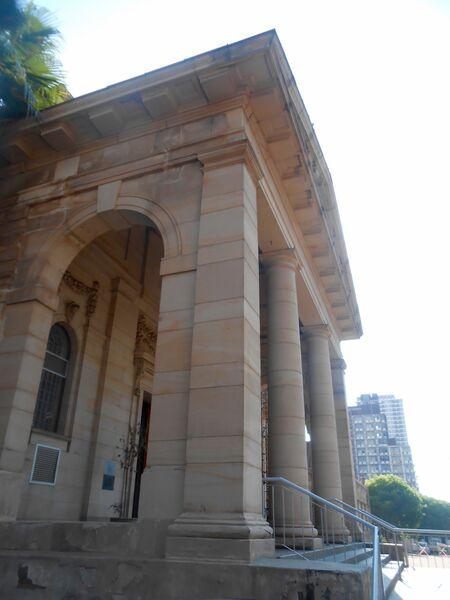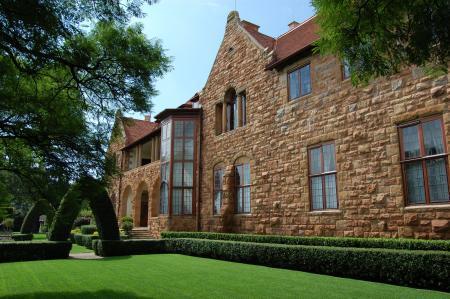
These days overseas travel broadens the mind and empties the pocket. Sometimes on a journey abroad an encounter with a work of art, recalls a remembered and much loved treasure at home and in a flash a whole new understanding drops into the brain. I had just such an experience in San Francisco recently when I discovered the fabulous European art collection of the Legion of Honour Art museum. San Francisco was lucky enough to be the beneficiary of the Spreckles collection of Rodin sculpture. There is not one Rodin sculpture but dozens on display inside and outside the museum. Among the collection is the magnificent marble bust by Rodin of Eve Fairfax. In this work the female head with copious hair emerges from the hewn marble. The woman is an expression of nature.
Eve Fairfax in the Spreckles collection of the Legion of Honour Art Museum, San Francisco (Rodin Website)
Photograph of Eve Fairfax (Rodin website)
Immediately I recall that one of my favourite works of art in the Johannesburg Art Gallery is the Rodin bust of Eve Fairfax. The Johannesburg Eve Fairfax delighted me from the time I was about six and first visited JAG with my mother. Michael Stevenson, in his book, "Art and Aspirationsm, the Randlords of South Africa and their Collections", included an illustration of the Rodin, Eve Fairfax bust, and encapsulated the story in the caption. Thelma Gutsche in her biography of Florence Phillips (No Ordinary Woman) , relates how The Miss Fairfax bust was shown to the citizens of Johannesburg in November 1910 as the centre piece of the new city art collection at the Transvaal University College. "In the middle stood Rodin's matchless Miss Fairfax in pure white marble surrounded by masses of deep mauve lupins." (Gutsche, p 259)
The Eve Fairfax marble bust in the Johannesburg Art Gallery, created by Rodin and carved in marble by Bourdelle.
That bust was the start of my education in art. I fell in love with the work as an object of beauty and enigmatic mystery. Later the mystery of the work, its mood, its look, the pristine purity of the white marble that made me reflect on the making of art and the relationship of sculptor and sitter. I have returned to the Johannesburg Eve Fairfax Rodin many times and each time I take away a fresh insight. It's an art work that lifts one mood and renews the soul. As a child I bought a sepia toned post card of the bust and kept the postcard for many years. It was the golden centre piece of the Johannesburg art gallery.
There is a bronze Miss Fairfax in the Victoria and Albert Museum, given to the museum by Rodin in 1914.
Eve Fairfax's fame rests entirely on her association with Rodin, as between 1901 and 1909 she was the model for his busts of her, his friend, his muse and correspondent. She was a young society woman of 29, when she became engaged to Ernest William Beckett, an English banker and Member of Parliament. He was a widower, but also had the reputation of being a philanderer of note and described by Hare as "a man of seemingly intense, short-lived enthusiasms". She was a member of an old distinguished Yorkshire family whose ancestry could be traced to Cromwellian times. He inherited the title and became the second Baron Grimthorpe in 1905. It was Beckett who commissioned the Rodin bust of his betrothed and there were several sittings. But this is where art and human relationships take strange turns as in 1905 the engagement was broken off and what remained is her likeness captured in several busts. There was considerable speculation as to why the relationship went awry, but the the art world was enriched by the inspiration of Eve and the several fine versions of her figure.
Lord Grimthorpe (Spy Cartoon)
This small book was commissioned by the Johannesburg Art Gallery in the early 1990s. The author, Marion Hare, a professional art historian from Canada and expert on Rodin's portraits, was engaged to write a catalogue on Rodin's marble bust of Miss Eve Fairfax. It is unusual though not unknown for a book, albeit a fairly slender volume, to be written on a single work of art. This book was an important study. It is now out of print and is hard to find. It has become an even more significant small volume in the growing literature not only on Rodin but also on Miss Fairfax. The price quoted on the overseas book market is now quoted at over $300. Hereby hangs a tale. The Hare study was published in 1994 as South Africa became a reborn country ushering a new emphasis on African art and with this trend came a visible slippage of interest and focus on European art or as now labelled "colonial" art. But Miss Fairfax cannot be consigned to the cupboard of art history; there is an international interest and the possession of just this one single work gives the Johannesburg Art Gallery an international presence.
The Johannesburg Art Gallery (The Heritage Portal)
Hare sets out in a workmanlike and direct way to give a brief recap of the career of Rodin and to present Rodin as eminent sculptor of character deep busts from the earliest bust of 1870 of his life-long companion Rose Beuret, to the shrouded brilliance of the Balzac figure (1898), too the portrayal of the world weary French Prime Minister, Georges Clemenceau (1911-13). A chapter follows on the sitter Eve Fairfax and how the bust came to be commissioned. The most important element of the book is the record of the correspondence of Rodin and Eve Fairfax, a significant archival item owned by JAG since 1950, there are 25 letters from Rodin and 116 from Eve. The most revealing 24 letters of Rodin are reproduced here together with Eve's side of the correspondence dating from 1902 to 1909. There's was a respectful and caring friendship, but there is no evidence that Eve was Rodin's lover. But this is one of those encounters where the romance and mystery shroud the sitter and truth gets displaced through the mists of time.
The creativity and the making of the portrait bust is developed in a core chapter. This is where Hare's deep scholarly approach pays dividends. Rodin himself wrote to a friend: "...you will never believe the tenacity it takes to make a bust and how hard one must fight to find and to render a true character within it accentuating and emphasizing the solid supple, ample and free forms". This quote sums up Rodin's approach to building up a three dimensional sculpture as an accumulation of profiles. Hare found that there were 10 plaster or terra-cotta studies of Eve Fairfax in the reserve of the Musee Rodin in Paris and seven of these were photographed and presented in this catalogue for the first time. It is fascinating to engage with the details of each model as you delve into Rodin's struggles to define character in a curl of hair, the line of the nape of the neck or the handling of the upper lip. A catalogue for an exhibition of Rodin's work in England in 1966/7, placed the Eve Fairfax bronze in the context of Rodin's admiration of the beauty of English women and that wherever possible he preferred to employ English models.
Rodin gave Eve the marble bust in 1907, it was shown at the Paris Salon in the same year. By 1907 there were four marble busts of Eve by Rodin. The existence of Eve in bronze, plaster, terracotta and marble in Musėe Rodin In Paris, in the Victoria and Albert Museum London, in Rome and at the Legion of Honour in San Francisco in addition to the Johannesburg marble, means that there is a collection for study and comparison, and Hare undertakes this task with erudition. In 1914 Rodin gave the bronze version to the Victoria and Albert Museum. This work was one of 18 works (16 bronzes, a marble and a terra-cotta) donated. By the mid sixties 17 of these works were in the Tate Gallery.
A final chapter traces the acquisition of the Rodin Fairfax bust by the Johannesburg Art Gallery, how introductions were effected to facilitate the purchase of the bust by Lady Florence Phillips directly from Eve Fairfax in 1909. Eve sought Rodin's blessing in her decision to sell her marble bust to a Randlord for Johannesburg. She received a cheque of £800 signed by Lionel Phillips, a not inconsiderable sum in Edwardian England (enough for a professional man and his family to live on for a year). Later Eve gave the correspondence with Rodin to the Johannesburg art Gallery.
The fascination of the story lies in the principal characters, hints of scandal, the mysteries and might-have-beens, behind their later lives. Following the breaking off of her engagement to Ernest Beckett, we know that Rodin was never paid for his work by Beckett, though the reason for non payment remains a mystery. We know that Beckett had made a purchase from Rodin of a small version of the work The Thinker. In 1911 Beckett, in a letter to Rodin, requested to visit Rodin's studio and to bring along a "young, beautiful and rich American, who is one of your greatest admirers". Ernest continues with a brazen shamelessness, "She dances in the Greek style and I find the poses very artistic". We do not know whether Lord Grimthorpe took his new female love interest to the Roden studio nor whether the young, rich, beautiful American ever sat for Rodin. It is is a tantalizing end to Hare's study. A strength of this small book is that it tries to get behind the myths and the inferences of scandal to concentrate on the immortality of the image of Eve Fairfax.
The book concludes with a chronology, the correspondence of Ernest Beckett to Auguste Rodin, a bibliography and a list of illustrations. There is no index. This is where the shortcomings of the book perhaps explain why this major study has been so neglected in other studies. The small black and white illustrations, and the layout of the book, which feels more like a pamphlet, do not do justice to the deep scholarship of the author.
Strangely there is another story yet to Eve Fairfax and with a little bit of Internet research the story of Eve Fairfax and Ernest Beckett can be likened to a Chinese puzzle. One delicate carved ivory ball fits within another and yet another. In 2010 the distinguished English biographer, Michael Holroyd published "A Book of Secrets, Illegitimate Daughters and Absent Fathers". The story of Eve Fairfax features in this book. It is a book about the lives, secrets and loves of three woman who connected through their association with Ernest Beckett and his villa in Italy. Beckett had three legitimate children by his marriage to Lucy Tracy Lee, an American heiress, but he was also the father of Violet Trefusis née Keppel, the daughter of Alice Keppel, who became the much loved mistress of Edward VII.
Remarkably Eve Fairfax lived until the age of 107 passing away in 1978. She remained a spinster all her life. She had no home of her own and depended on the care and friendship of family and friends moving as a guest around the country homes of England. She regretted that she never married, as in an unmarried state without a solid income her social position was precarious. Holroyd commented in a newspaper interview with the Yorkshire Post, "she lost her legitimate place in society because she did not marry". One now understands why her friendship with Rodin was so important to her and why she came to sell the marble bust to Johannesburg. She needed the money to live and a marble bust was clearly a difficult traveling companion.
This sort of subject draws one into wanting to know more and I found a reference and illustration online of a bronze of Eve Fairfax, age 101, created by an English artist, Toddy Hoare Oas. That must surely be a record. Eve continued to attract admirers and her story with its overtones of loss, mystery and tragedy appeals. From 1909 Eve kept a large autograph book / cum social calendar, and this was her one constant travelling companion that kept her secrets. How I would love to see this secret book! It was this book that inspired Michael Holroyd. That is the fun of being a bibliophile... one book leads to another and the human story is endlessly fascinating.
Toddy Hoare Oas' bronze of Eve Fairfax, created when she was 101.
2016 Guide Price: The book is now out of print and difficult to find. It is a book that was a reference source for Holroyd and it is Holroyd's romanticization of the story Fairfax/ Beckett / Keppel and associated characters that gives a new appeal to the Hare book. It has now become a much sought after rarity. If one feeds the title into Amazon or Abebooks requests one can purchase a copy of this slender work abroad for anywhere between £227 and $345. On the local market a copy was sold locally on Bidorbuy in February for R30.
Of course one story leads to another...
It may be interesting for the reader to follow another fascinating strand. An earlier lover and mistress of Ernest William Beckett was the daring young adventure loving lass from the Cape Josephine Brink, better known to us as the Johannesburg socialite and hostess Jose Dale Lace, married to mining magnate, John Dale Lace. José too was a beautiful young woman in the 1890s and ready to flaunt convention. Did Eve Fairfax know of the extraordinary and rather questionable behavior of Ernest and José a few years prior to her engagement to Ernest? It was a liaison that produced a son Lancelot, who was adopted by John Dale Lace and took his name. If she did not know, was she a naive 30 year old or if she knew about Ernest Beckett's previous mistresses, was she ready to accept that standards of behavior in her day differed for men and women? The story ends with more questions and answers and reveals social history to be fraught with personal recollection, faulty memory and too many unknowns, leading to speculation and a slippage from the art of the biography to that of the novelist.
Northwards (The Heritage Portal)
At Northwards, the Edwardian mansion, designed by Herbert Baker for Jose and John Dale Lace in 1903, there is a full length rather grand oil painting of Jose Dale Lace by Hal Hurst (English artist, illustrator, and miniaturist). This work was exhibited at the Royal Academy in 1903, and shows a woman of determination, romantically presented in pink full length evening gown, bare shouldered, narrow waisted and decidedly beautiful. It is an Edwardian society portrait but it lacks the enigmatic depth and mystery of Rodin's Miss Fairfax. It still hangs in the main reception room of Northwards.
How extraordinary that two works of art now preserved and part of Johannesburg's history and heritage should reveal a connection between these two women. While José Dale Lace made her home in Johannesburg, Eve Fairfax sold her greatest claim to fame to the city she never visited.
José Dale Lace - The Hal Hurst portrait at Northwards
Further reading
- Michael Stevenson: Art and Aspirations The Randlords of South Africa and their collections, (Fernwood Press, 2002)
- Marie-Pierre Delclaux: Rodin, a Brilliant Life (Editions du Musée Rodin, Paris, 2003)
- Thelma Gutsche: No Ordinary Woman (Howard Timmins, 1966)
- Sommerville Story (introduction): Rodin Sculptures. (Phaidon , Oxford, 1979)
- Catalogue- Rodin, an exhibition of sculpture with some drawings and prints organized by the Arts Council, England 1966- 7
- Michael Holroyd, A Book of Secrets, illegitimate daughters , absent fathers (Chatto and Windus, 2010
- Daphne Saul: Bird of Paradise José Dale Lace (Parktown and Westcliff Heritage Trust, 1986)
Kathy Munro is an Honorary Associate Professor in the School of Architecture and Planning at the University of the Witwatersrand. She enjoyed a long career as an academic and in management at Wits University. She trained as an economic historian. She is an enthusiastic book person and has built her own somewhat eclectic book collection over 40 years. Her interests cover Africana, Johannesburg history, history, art history, travel, business and banking histories.


